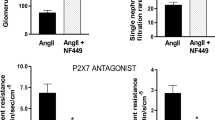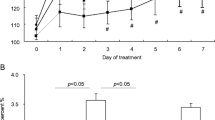Summary
Rabbit renal cortices were fractionated by collagenase dispersion and glomeruli, microvessels and tubuli purified on a discontinuous sucrose gradient. Binding experiments with (−)[125I]N6-(4-hydroxyphenylisopropyl)-adenosine ([125I]HPIA) provided evidence for the presence of A1-adenosine receptors in the glomerular and microvascular fraction. With glomeruli, saturation isotherms for specific [125I]HPIA binding were mono-phasic with a K D of 1.3 nmol/l and a B maxof 7.7 fmol/mg protein. In kinetic experiments, an association rate constant of 4.9 × 105 (mol/ 1)−1 s−1 and a dissociation rate constant of 4.3 × 10−4 s−1 were obtained, yielding a K D of 0.9 nmol/l. Adenosine analogs displaced [125I]HPIA binding with a rank order of potency typical of A1-adenosine receptors; furthermore, binding was inhibited by methylxanthines and modulated by GTP. Saturation experiments with the microvessels revealed a K D of 1.9 nmol/l and a B max of 13.4 fmol/mg protein. However, no inhibition of glomerular and microvascular adenylate cyclase activity could be demonstrated, but instead both 5′-N-ethylcarboxamido-adenosine (NECA) and N6-(R-phenylisopropyl)-adenosine (R-PIA) stimulated enzyme activity, with EC50 values of 0.14 μmol/l and 1.5 μmol/l, respectively. The concentration-response curve for NECA was shifted to the right (factor 9) by 10 μmol/l 8-phenyltheophylline. On the other hand, computer simulation of biphasic curves (adenylate cyclase inhibition in the presence of activation via a stimulatory receptor) indicates that the failure to observe an A1-adenosine receptor-mediated inhibition of adenylate cyclase activity in the presence of stimulatory adenosine receptors may be attributable to methodological constraints. The results demonstrate that both A1- and A2-adenosine receptors are present in rabbit glomeruli and microvessels. It is suggested that both receptors are involved in the control of renin secretion.
Similar content being viewed by others
Abbreviations
- R-PIA:
-
(−)N6(R-phenylisopropyl)-adenosine
- NECA:
-
5′-(N-ethyl-carboxamido)-adenosine
- S-PIA:
-
(+)N6-(S-phenylisopropyl)-adenosine
- I-HPIA:
-
(−)N6-(3-iodo-4-hydroxy-phenylisopropyl)-adenosine
- HPIA:
-
(−)N6-(4-hydroxyphenylisopropyl)-adenosine
- [125I]HPIA:
-
(−)N6-(3-[125I]iodo-4-hydroxy-phenylisopropyl)-adenosine
- ATP:
-
adenosine-5′-triphosphate
- cAMP:
-
cyclic 3′,5′-adenosine-monophosphate
- GTP:
-
guanosine-5′-triphosphate
- HEPES:
-
4-(2-hydroxyethyl)-1-piperazine-ethanesulfonic acid
- EDTA:
-
(ethylenedinitrilo)-tetraacetic acid
References
Abboud HE, Dousa TP (1983) Action of adenosine on cyclic 3′,5′-nucleotides in glomeruli. Am J Physiol 244:F633-F638
Arend LJ, Haramati A, Thompson CI, Spielman WS (1984) Adenosine-induced decrease in renin release: dissociation from hemodynamic effects. Am J Physiol 247:F447-F452
Böhm M, Brückner R, Neumann J, Schmitz W, Scholz H, Starbatty J (1986) Role of guanine nucleotide-binding protein in the regulation by adenosine of cardiac potassium conductance and force of contraction. Evaluation with pertussis toxin. Naunyn-Schmiedeberg's Arch Pharmacol 332:403–405
Cheng YC, Prusoff WH (1973) Relationship between the inhibition constant K i and the concentration of inhibition which caused 50% inhibition (IC50) of an enzymatic reaction. Biochem Pharmacol 22:3099–3108
Churchill PC (1982) Renal effects of 2-chloroadenosine and their antagonism by aminophylline in anesthetized rats. J Pharmacol Exp Ther 222:319–323
Churchill PC, Churchill MC (1985) A1 and A2 adenosine receptor activation inhibits and stimulates renin secretion of rat renal cortical slices. J Pharmacol Exp Ther 232:589–594
Helwig JJ, Judes C, Bollack C, Mandel P (1984) Isolation and characterization of a microvascular fraction from rabbit kidney cortex. Renal Physiol 7:146–155
Hüttemann E, Ukena D, Lenschow V, Schwabe U (1984) Ra adenosine receptors in human platelets. Characterization by 5′-N-ethylcarboxamido[3H]adenosine binding in relation to adenylate cyclase activity. Naunyn-Schmiedeberg's Arch Pharmacol 325:226–233
Itoh S, Carretero OA, Murray RD (1985) Possible role of adenosine in the macula densa mechanism of renin release in rabbits. J Clin Invest 76:1412–1417
Keeton TK, Campbell WB (1980) The pharmacologic alteration of renin release. Pharmacol Rev 32:81–227
Klotz KN, Lohse MJ, Schwabe U (1986) Characterization of the soluble A1 adenosine receptor from rat brain membranes. J Neurochem 46:1528–1534
Kusachi S, Bugni WJ, Olsson RA (1984) Forskolin potentiates the coronary vasoactivity of adenosine in the open-chest dog. Circ Res 55:116–119
Lang MA, Preston AS, Handler JS, Forrest JN Jr (1985) Adenosine stimulates sodium transport in kidney A6 epithelia in culture. Am J Physiol 249:C330-C336
Linden J (1984) Purification and characterization of (−)[125I]-hydroxyphenylisopropyladenosine, an adenosine R-site agonist radioligand and theoretical analysis of mixed stereoisomer radioligand binding. Mol Pharmacol 26:414–423
Linden J, Patel A, Sadek S (1985) [125I]Aminobenzyladenosine, a new radioligand with improved specific binding to adenosine in the heart. Circ Res 56:279–284
Lohse MJ, Lenschow V, Schwabe U (1984) Two affinity states of Ri adenosine receptors in brain membranes. Analysis of guanine nucleotide and temperature effects on radioligand binding. Mol Pharmacol 26:1–9
Lohse MJ, Ukena D, Schwabe U (1985) Demonstration of Ri-type adenosine receptors in bovine myocardium by radioligand binding. Naunyn-Schmiedeberg's Arch Pharmacol 328:310–316
Murphy KMM, Snyder SH (1982) Heterogeneity of adenosine A1 receptor binding in brain tissue. Mol Pharmacol 22:250–257
Murray RD, Churchill PC (1984a) The concentration-dependency of the renal vascular and renin secretory responses to adenosine receptor agonists. J Pharmacol Exp Ther 222:447–451
Murray RD, Churchill PC (1984b) Effects of adenosine receptor agonists on the isolated, perfused rat kidney. Am J Physiol 247:H343-H348
Osswald H (1983) Adenosine and renal function. In: Berne RW, Rall TW, Rubio R (eds) Regulatory function of adenosine. Martinis Nijhoff, The Hague, pp 399–415
Osswald H, Spielman WS, Knox FG (1978) Mechanism of adenosine-mediated decreases in glomerular filtration rate in dogs. Circ Res 43:465–469
Raberger G, Schütz W, Kraupp O (1978) Cardiovascular and metabolic actions of an adenosine analogue (2′,3′-O-methoxyethylidene-adenosine-5′-ethylcarboxamide) in the conscious dog. Arch Int Pharmacodyn 232:150–157
Schütz W, Tuisl E, Kraupp O (1982a) Adenosine receptor agonists: binding and adenylate cyclase stimulation in rat liver plasma membranes. Naunyn-Schmiedeberg's Arch Pharmacol 319: 34–39
Schütz W, Steurer G, Tuisl E (1982b) Functional identification of adenylate cyclase-coupled adenosine receptors in rat brain microvessels. Eur J Pharmacol 85:177–184
Schütz W, Freissmuth M, Hausleithner V, Tuisl E (1986) Cardiac sarcolemmal purity is essential for the verification of adenylate cyclase inhibition via A1-adenosine receptors. Naunyn-Schmiedeberg's Arch Pharmacol 333:156–162
Schulz DW, Mailman RB (1984) An improved, automated adenylate cyclase assay utilizing preparative HPLC: effects of phosphodiesterase inhibitors. J Neurochem 42:764–774
Schwabe U, Lenschow V, Ukena D, Ferry DR, Glossmann H (1982) [125I]N6-p-Hydroxyphenylisopropyladenosine, a new ligand for Ri adenosine receptors. Naunyn-Schmiedeberg's Arch Pharmacol 321:84–87
Schwabe U, Ukena D, Lohse MJ (1985) Xanthine derivatives as antagonists at A1 and A2 adenosine receptors. Naunyn-Schmiedeberg's Arch Pharmacol 330:212–221
Silver PJ, Kazmeres W, DiSalvo J (1984) Adenosine-mediated relaxation and activation of CAMP-dependent protein kinase in coronary arterial smooth muscle. J Pharmacol Exp Ther 228:342–347
Skatt O, Baumbach L (1985) Effects of adenosine on renin release from isolated rat glomeruli and kidney slices. Pflügers Arch 404:232–237
Spielman WS, Thompson CI (1982) A proposed role for adenosine in the regulation of renal hemodynamics and renin release. Am J Physiol 242:17423–17435
Tagawa H, Vander AJ (1970) Effects of adenosine compounds on renal function and renin secretion in dogs. Circ Res 26:327–338
Ukena D, Furler R, Lohse MJ, Engel G, Schwabe U (1984) Labelling of Ri adenosine receptors in rat fat cell membranes with (−)[125iodo]N6-hydroxyphenylisopropyladenosine. Naunyn-Schmiedeberg's Arch Pharmacol 326:233–240
Ukena D, Schirren CG, Klotz KN, Schwabe U (1985) Evidence for an A2 adenosine receptor in guinea pig lung. Naunyn-Schmiedeberg's Arch Pharmacol 331:89–95
Author information
Authors and Affiliations
Additional information
Send offprint requests to W. Schütz at the above address
This study was supported by the Fonds zur Förderung der wissenachiftlichen Forschung in Österreich (Project 5712)
Rights and permissions
About this article
Cite this article
Freissmuth, M., Hausleithner, V., Tuisl, E. et al. Glomeruli and microvessels of the rabbit kidney contain both A1- and A2-adenosine receptors. Naunyn-Schmiedeberg's Arch Pharmacol 335, 438–444 (1987). https://doi.org/10.1007/BF00165560
Received:
Accepted:
Issue Date:
DOI: https://doi.org/10.1007/BF00165560




